Lingbo Li
Kalaw, Myanmar: “I am alone, but I am not lonely”
I arrive in Kalaw, the same as I arrive in every new city. Dusty. Head pounding. Disoriented.
My guesthouse in Kalaw is styled like a ski lodge. There’s wood and woven bamboo paneling, pen sketches of hill tribe people, and a local parasol adorning the walls. Throw in a private bath for 8 bucks, and i am one happy, if still slightly sick, camper. I’m here to do a 2-3 day trek to Inle Lake, passing through the hill tribe villages along the way.
An employee directs me to the viewpoint. I start climbing the hill, spooked by the barking of dogs after a conversation with my bus buddy on the way here about rabies. I clutch stones in my fists, feeling vulnerable.
I reach the top of the dirt road, passing woman carrying bushels of ferns. From the top, Kalaw is a charming slate-and-blue patchwork of corrugated tin rooftops lit by a cold, white sun. I walk into the temple grounds.
There is a golden stupa, guarded by an aggressive dog. He runs out and keeps barking at me. I freeze, clutching the stones and thinking, somewhat obsessively, getting to Bangkok for rabies shots would really suck.
After awhile, I starting inching away. I hear the jingle of the dog’s collar following me.
Then I see the monk, sitting in a tiny white house to the right of the stupa. I wave, and he walks out to greet me. The dog turns away, panting and satisfied.
“Mingalaba!” I say.

He smiles. He is missing many of his yellowed teeth, and a bit of saliva collects at the corner of his mouth as he talks. He looks frail, swaddled in ochre robes and wearing glasses with the faded price sticker still affixed to the lens.
We exchange the usual pleasantries. His English is hard to understand, so I just end up trying to process his stream of Buddha thoughts. He reads the words painted on his door and walls: “the art of dying” “I am alone but I am not lonely” “Open mind means entirely empty mind” “this too, will pass.”
“You just one?” he asks, holding up a forlorn finger.
“Dae yao,” I say, which is Myanmar for alone. Coincidentally, it sounds similar to the word for China – “Dai yao.”
He laughs with delight. It is always worth learning a few words of the local language to experience this. “You strong!”
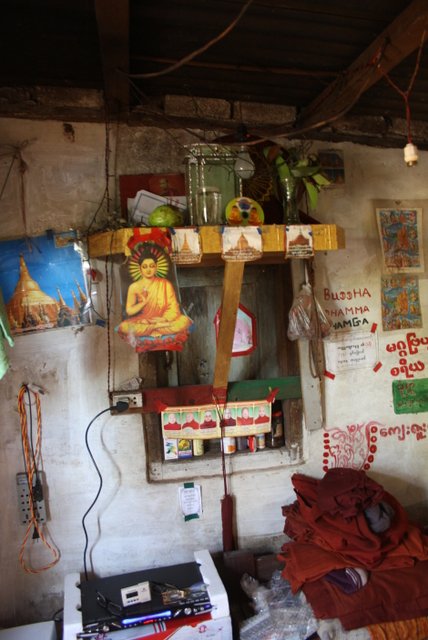
I flex my biceps. Based on my Lonely Planet, I was expecting pity. I always read their “woman travellers” section with particular care. I’ve realized that this section is often written by men. It amazes me how much of my expectations of travel have been based on white, male accounts. The China I experience – the Thailand I experience – the Myanmar I experience – never feel the same.
I am less bothered – especially now, in (what feels like) the absurdly safe holds of Myanmar – about how my travel experience differs from a man’s.
Sometimes, I try to explain to my male travel partners What It’s Like To Be A Woman. I say things like, “Sometimes you wonder if he’s being creepy or if it’s a cultural difference. The fact you’re wondering means he’s being creepy. Full stop.” I try to explain what it means to always be aware of being female. Why catcalling isn’t just flattering background noise. I’m not sure if they understand, but it’s helpful to clarify for myself.
The monk offers me coffee.
Why not? He pours hot water from a carafe into a dirty plastic cup and pours in a 3-in-1 coffee mix. I pray fervently that this doesn’t upset my recovering stomach. I drink some coffee, take pictures of his abode, and we say goodbye.
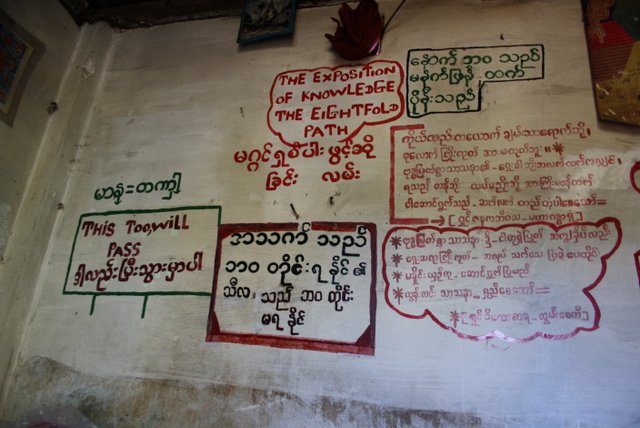
I wonder if he is lonely. He had told me I was beautiful, several times. Then I remember that English phrase, painted on the wall at the foot of his bed: I am alone but I am not lonely.
Why Being Aimless Is a Good Thing

Thailand Sunset
It’s been one year since my decision to “take a year off.”
It was one of the best decisions I ever made. In the past year, I’ve eaten tacos al pastor in Mexico City, hiked up and down the streets of San Francisco, wrestled with existence and danced on art cars at Burning Man in Nevada’s desert, popped by Vegas for a weekend, reconnected with friends, and did a monster backpacking trip through Shanghai, Thailand, Malaysia, Cambodia, and Myanmar.
I’ve learned how to ride a motorbike, scuba dive, navigate the streets of a foreign country, take total responsibility for my own safety, speak a little Thai and Burmese, and the fine art of haggling. I’ve gotten sick, lost, scared, and dejected, but when you’re on the road for over 4 months, every moment passes, only to reveal a more beautiful one.
I started off with no guidebook or plan. I knew I wanted to start in Bangkok and end up in Shanghai for my return flight home. Everything in between – those 4 months – happened by magic, wish, circumstance. It was the best trip I could have asked for, even if I had no idea what was in store.
————-
In Kampot, Cambodia, I took a small boat out to Rabbit island, where I swam in warm, waist deep cerulean water and picked at fresh crabs. I met a movie cast of characters there: a chatty New Zealand pork importer with his friendly Thai girlfriend; an American and recovering drug addict named David who’d spent the last four years in Kuwait, building boxes for the military; a spritely 70-something British woman, still backpacking solo around the world and flaunting a bikini. I swung in a hammock and drank juice out of a coconut. The Cambodian coastline and mountains were delicate watercolors in the distance; the palm fronds arched over the island lip and into the merged blue of sky and water.
Is this what I had feared? Is this where aimlessness takes me? A bright, intense happiness filled me, as it had and would throughout my trip.
That thought was coupled with a kind of quiet pride: I am here, because I decided to be here. And how lucky I am to be here.
————-
Why do so many grads take jobs they don’t care for?
I don’t think the answer necessarily lies in social pressures.
Rather, we feel like we have to have a plan. A goal. And if you don’t have a plan or goal of your own, someone else’s will do. Aimlessness is something to be feared, pitied, ridiculed. It is anathema to a culture that values career accomplishment. But even more important, students don’t believe they can – or are too afraid – to come up with their own goals. What if those goals are “wrong”? What if they lead to failure?
I realized that my underlying fear was not unemployment. (That’s why I applied to jobs before making the leap to self-employment. I wanted to make sure I was actually employable.) It was not social pressure, although I felt that too. The true fear, buried below all my rationalizing, was much more insidious.
Without a structure – without somebody to tell me what to work towards – would accomplish anything at all? Did I even have goals of my own? Would I just procrastinate all day long and achieve nothing? Without a system to prod and reward me, would I collapse into a goo of TV-watching underachievement?
That is… a failure?
This is what I truly feared.
I’ve heard people deride self-help books and gurus as full of too much fluffy positive thinking advice. I get annoyed about that too. But truthfully, the deeper I get into following an unconventional path, the more I realize that our biggest obstacles are mental. Most things in life are not particularly difficult – they merely take time and persistence.
And that’s where most of us break down. Do I really want this? Is this really worth it? The decisions become overwhelming; the logistics convoluted; our bodies fatigued. And so we do something else that doesn’t awaken that doubt, at least for awhile.
It’s easy to get afraid of the questions, and the (very real) pain they cause. We’d like to assign some stability to the world as we understand it. To change the underpinnings of our beliefs is like someone snatching a security blanket from a child. You worry that doubting one thing will lead to another, and soon you’ll be so lost you can’t climb your way out anymore.
But it takes a different mind, and a stronger and wiser mind, to hold concurrent realities as all equally valid.
I found a funny thing though. It was only when I got lost – really, really lost – that I found I had a sense of internal direction after all. Sometimes, that lostness was so profound that I’d literally lost all trappings of identity. Sometimes, that lostness was the chaotic overwhelm that led to homesickness, fatigue, and a trip to the doctor for antibacterial meds.
Somehow, if you push up against lostness enough, it quiets down the other voices and points you towards what’s actually important. I learned to listen to what I wanted, and realize that I called the shots.
I love Steve Jobs’ Stanford commencement address. I listen to it whenever I need a reminder to keep going forward, even when I’m lost and don’t have a plan:
Again, you can’t connect the dots looking forward; you can only connect them looking backwards. So you have to trust that the dots will somehow connect in your future. You have to trust in something — your gut, destiny, life, karma, whatever. This approach has never let me down, and it has made all the difference in my life.
So don’t be afraid of questioning, of being aimless. You are strong enough to handle it. You’ll be ok.
Tips and Recommendations for Backpacking through Southeast Asia
Time for some Question and Answer action!
Hey Lingbo,
I hope you’re doing grand (and I’m a bit sad that my google reader hasn’t updated anything from your blog in awhile!) and that you find yourself in Brazil on your South America trip.
I’m writing because I want your input and advice. I’m quitting my job at the end of May, subletting my place, and basically just kicking it til med school starts in August. I have between 6-8 weeks of uninterrupted time to travel, by myself, something I’ve been wanting to do for a long time, to Southeast Asia and see glorious beaches in Thailand, or the coves of Halong Bay, or try hokkien mee on the street, and just see a different part of the world.
Seeing as you’ve went, and this would be one of my first solo experiences for fun (and where i don’t speak local languages other than some French), do you have any advice? Recommendations? Even proposed itineraries? Anything would be helpful.
Much obliged,
Traveling Penguin
Dear Traveling Penguin,
First of all, congratulations on med school and deciding to do some solo travel! Solo travel is awesome, and you are in for a treat.
With 6-8 weeks, you have a decent chunk of time, but not not enough to traverse the continent without running yourself ragged. I would recommend picking 2-4 countries. 2, for a more immersive experience, and 4, if you’re going to do more of a “greatest hits” tour.
Southeast Asia is extraordinarily easy to get around, overland travel can be booked on the fly and is dirt cheap, and your plans will inevitably change (embrace this change!). Logistics that seem daunting when you’re stateside are effortless once you’re there. So most of all, don’t worry, just trust you’ll figure it out as you go along.
Most importantly, figure out a start and an end point. Stare at a map really, really hard, pick out some “must visits,” then figure out a general order (are you going from north to south, or south to north), and figure out where to go in between once you’re there.
Most people start in either Bangkok or Singapore, since international flights will be cheapest there. If you start in Bangkok, you could decide to head north to Chiang Mai, or cross into Cambodia’s Siem Reap by train and see the temples of Angkor Wat, diddle around for awhile, then cross by bus/ferry into southern Vietnam. Or maybe you’ll hit up northern Laos first, then take bus or flight over to northern Vietnam (make sure you get a visa in Bangkok first).
Make sure to get visas for Vietnam and Myanmar in Bangkok, if you plan on visiting those countries. I highly recommend Myanmar, despite the logistical challenges. I had an incredible time there – some magical experiences and the nicest locals ever. As a side note, food is not the greatest there.
In the other direction, you could fly down to Indonesia from Bangkok and work your way back up north to Bangkok via Singapore (most recommend 3-4 days there), Malaysia, and the Thailand islands.
Whatever you do, make sure you check weather patterns for your time there – it may be monsoon season in many places.
My Picks
Bangkok is a nice place to start. You’ll probably end up staying on Khao San Road, which is the backpacker mecca of the world. It’s a bit sleazy and grimy, but that is ok for now. Plenty of traveler amenities here and a chance to get your bearings.
Thailand tourist rundown
If you’re looking to hop around Thailand, here is the quickest rundown of some (rather touristy) spots. I think it’s not a bad idea to start your trip off with some touristy places, just to get a handle on traveling.
Pattaya (not an island): mostly for sex tourists. Avoid if you’re not a sex tourist.
Phuket: one of the most developed islands – mostly big resorts and a lot of sex tourists.
On the east side:
Koh Samui: Another large, well-developed island.
Koh Phangan: Home to the infamous Full Moon Party. Worth a look if you find a group you like to party with (meet up with some people at a Samui hostel), but I wouldn’t go alone, particularly as a female. It’s a bit douchey, but fun if you like huge beach parties.
Koh Tao: Cheapest place to get scuba certified.
On the west side:
You’ll probably take a bus to Krabi Town or Ao Nang, then take a longboat to the islands from there.

Rai Lay Beach: Must see! Laid back, incredibly beautiful, blue waters and soaring limestone cliffs, mixed crowd. Stay on Tonsai for the backpackery/climber crowd.

Koh Phi Phi from the viewpoint
Koh Phi Phi: For 20-somethings that love to party. Stay away if you don’t like these kinds of tourists. If you go here, make sure to hike to the viewpoint.
Koh Lanta: Super chilled out, one of my personal favorites. Good for relaxing, good food, good place to rent a motorbike and explore.
Koh Lipe: Most beautiful water/beach I’ve seen so far, but pretty dull otherwise. Mostly for families/couples.
There’s a lot of other places in Thailand other than islands/beaches! Consult your Lonely Planet for advice. If you’re looking to get away from tourists, head away from the water.
Elsewhere
I will refrain from writing rundowns of everywhere, but here are a few of my fondest memories:
Penang, Malaysia: Fantastic street food.

Rabbit Island
Kampot, Cambodia: A golden, sleepy town in southern Cambodia surrounded by picturesque countryside (great for motorbiking), soaring mountains, and one of my favorite islands. Nearby Kep is full of abandoned colonial houses and great fresh seafood. Take a boat out to Rabbit Island for an overnight trip, you won’t regret it. A great place to chill out for a week or two in between hardcore travel.

If this guy offers you a ride, say yes!
Monywa, Myanmar: Off the beaten track. One of my favorite days of my trip: met an incredible motortaxi driver named Saw on the street, great street food, friendly people.
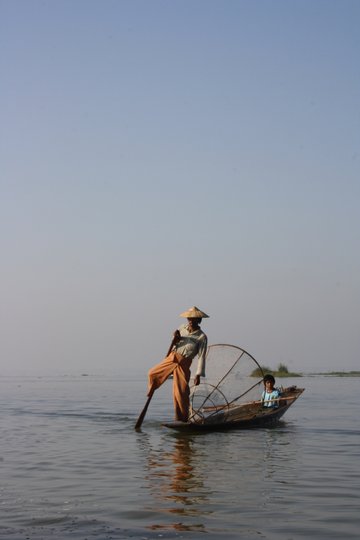
Fisherman in Inle Lake
One of the most beautiful, picturesque places of my entire trip. Mountain ranges surrounding waterways and fishing villages. Make sure you bike out to the jetty and eat at a little restaurant which has stunning panoramic views for all of a dollar. Be sure to stay at Aquarius Inn: http://www.tripadvisor.com/Hotel_Review-g303662-d1536830-Reviews-Aquarius_Inn-Nyaungshwe.html
Malacca, Malaysia: Another great place to chill out in between big destinations. Great food, and I loved the guesthouse I stayed at: http://www.hostelbookers.com/hostels/malaysia/malacca/48178/
But honestly, I had amazing times in not-so-choice destinations just because of the people I met. (Phnom Penh is totally skippable, but I had a great week there, anyway. Hi Simone!) It’s not so much about where you go, but what you make out of it.
Make sure to use Couchsurfing.com both to experience local hospitality and for meetups if you’re in an area that organizes them. I met some fantastic friends and travel partners this way.
Places I would go in the future:
– Heard amazing things about East Timor. I’d love to get more “off-the-beaten-track.” (You will hear this phrase a lot.)
– Indonesia, somewhere.
– Palawan, Philippines and Boracay. Stunning island scenery and cheap beer.
– Laos.
$$$
You can do very reasonably on about $30/day in most places. Since you’re going during low season, you’ll probably be ok just showing up, but it’s always useful knowing where you’re going once you arrive somewhere. You can make hostel/guesthouse bookings online at places like HostelBookers.com and Agoda.com (which has a $2 booking fee). Never forget you can bargain for you room, and indeed, ANYTHING, especially if you’re staying more than 1 night.
You can also get free food/stays in return for working at a hostel – just inquire.
Get comfortable with bargaining!
Transport
… is pretty easy, but remember that AirAsia is great for cheap airfare. HOWEVER, you may have issues with your US credit card (I did), so be sure to buy well in advance, and possibly have someone back home buy your ticket for you if you’re having issues.
Health
Bring diarrhea meeds and rehydrating salts. You will probably have digestive issues. It’s ok, happens to everyone.
Make sure to treat every single cut/scratch/whatever with extreme seriousness. I never bother bandaging or disinfecting minor cuts in the US, but everything gets infected in the tropics. So be super diligent!
Drink bottled water, wear a helmet, buy travel insurance, use protection, bring a universal travel adaptor, etc.
Packing
Bring as little as possible. As. Little. As. Possible.
The Most Important Thing
My biggest piece of advice is: accept every single moment. I had a lot of times when I was pissed off at where I was, who I was with, etc. instead of just accepting it and enjoying it. Every person and experience brings something valuable to your travels. As long as you keep a positive attitude and an open mind, you’ll have a great time no matter where you go.
Also, don’t be afraid to chill out. Everyone has a different physical tolerance, so if you’re tired, rest. Take care of your body. I’d take “a week off” every 3 weeks and just do some work.
And learn more than “hello” and “thank you” everywhere you go. I loved the instant gratification of learning languages while you’re abroad – and the smiles you receive in return are incredible.
Bon voyage! You’re going to experience the beautiful, the ridiculous, the sublime. It’s going to be great.
How To Dress When Backpacking: Or, You’re Doing it All Wrong
At home, I usually pride myself as a reasonably put-together person. I may only wear one pair of shoes… but they’re a pair of platform wedges. I wear more dresses and skirts than the average college student. I at least attempt to swipe on black eyeliner and some concealer.
However, backpacking takes away all your pretensions. There you are, dancing away in light-up Minnie Mouse ears and sweatpants while some Australian dude spills a bucket of whiskey coke all over you. Oops. God forbid you get in the way when a Thai bartender slams a beer bottle on belligerent reveler, knocking him bloodied and unconscious.
So let me share my style lessons.
1) Flip flops. I’ve scaled steep, slippery rocks in a bikini and flip flops. I’ve motorbiked in flip flops. I’ve partied in flip flops. I would probably scuba dive in flip flops if it made any sense. Pro tip: after Full Moon Party on Thailand’s Koh Phangan, hundreds of flip flops wash up on the beach by mid-morning. Free flip flops galore!!

Looking like a rectangle is really hot this season!
2) Parachute pants. You see all those hippie backpackers with the dreads and funny looking pants. You laugh at them silently and think, gross hippie backpackers! I’m not like them! Then your hair gets all dusty and matted and locals ogle you because you’re wearing shorts and a tank top, plus it’s just really hot. Then you realize that parachute pants are God’s gift to backpackers: cheap, comfortable, cooling, light, and let you sprawl around without being indecent. Just be careful when getting on bikes or motorbikes – I always end up getting twisted around the back of the seat. Thank you, hippies, for letting me see the light.
3) Helmets. I have worn so many suspect motorcycle helmets. The top will be so scratched that it looks like the previous owner was tossed headfirst from a cliff. The buckle won’t stay buckled. The visor will be hanging off one hinge. Wear your damn helmet. And make sure the buckle works. Remember, don’t do drugs and go tubing/cliff jumping/rope swinging.
4) Viscose. Let me champion the cause of manmade fibers. These wholly unnatural fabrics will dry with amazing speed after a day of carting your 20 kilo (see, I’ve been away from the US too long) backpack and trying to haggle with tuk-tuk drivers by making silly duck faces after their ridiculous first offer. It helps me avoid getting angry, which is the kiss of death for haggling in these parts. So don’t get angry. Make weird duck faces, puppy faces, hop around like a rabbit, something. Laugh. Then, “You give me good price?” They will be so confused, they might just slip up. Also, if you just stay silent for a long time, then walk away, that works too.
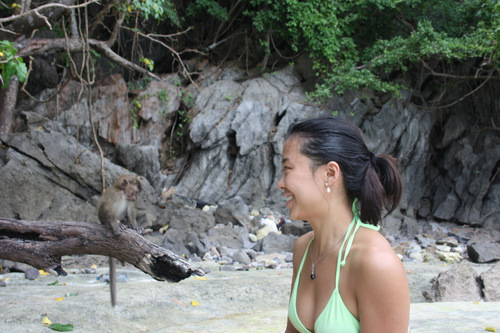
Baby monkey!
5) Swimwear. If you pay the exorbitant fee to go walk in the shark tank at Bangkok’s aquarium, they give you a bikini for free. Free! For only the cost of a lame shark tank experience that could easily net you 2 real scuba dive sessions in a beautiful island dive site. Not worth it. But good for feeding monkeys in.

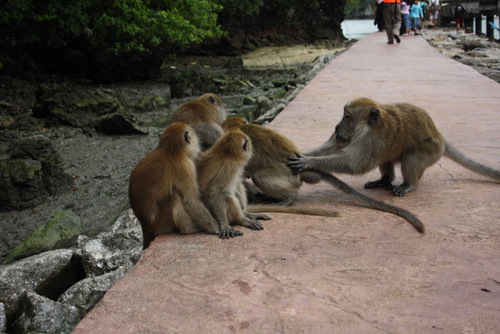
5a) Monkeys. They are not your friends!
5b) Monkeys, part II. Monkeys are like rats, but cuter and with brainpower and opposable things. Think about how terrifying this is. They will snatch your plastic bags and potato chips. If you try to feed the baby monkeys, the big monkeys will yell and take their food. However, they’re pretty cute when you throw them pineapple chunks from your kayak and they wash the food first before eating it. Repeat after me: Monkeys = not your friends.
6) Hair ties. Buy them at 7-Eleven. Or cut a section off your pantyhose.

7) Pants. Wear them when you ride elephants bareback. Their hair is really coarse and wiry. Also, you shouldn’t ride elephants bareback. At least, I don’t think you’re supposed to. But no one else was watching and the Thai guy said it was fine. “Will I fall off?” “No no,” he says, smiling. Good luck.
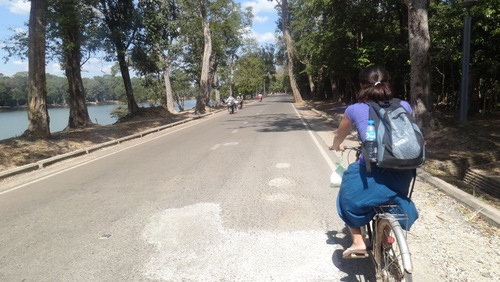
Biking through Siem Reap, Cambodia
8) Daypacks. Motorcycle bag snatches are not uncommon here. Sometimes, the thief will carry a knife to slash your bag strap as they make a 2-wheeled getaway. Always let go, or else you’ll get dragged into the street and I will cry. So, like the anxious wreck I am, I carry a small backpack everywhere. I bought it in Ipoh for like, 30 Ringgit. (~$10) Which was too much. I saw a pile at the discount store in Kuala Lumpur for $15 Ringgit. (~$5) I should have bargained harder! My backpack brings all the boys to the yard. Along with my juvenile Asian pencil case that I stick antibiotics, eyedrops, and bandaids in.
9) Skin ailments. Not usually part of my beauty routine. At least to not to this scarring degree. But I like to think my shoulders, once pristine and now populated with white, polka-dot like patches, are the new fashion trend. Backpacker skin FTW!
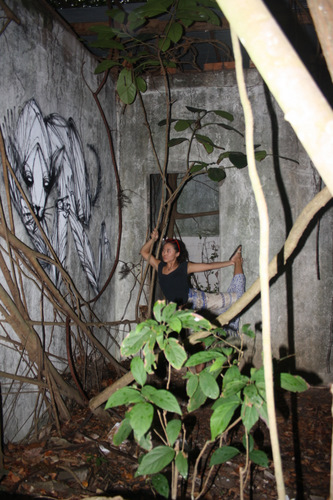
10) Sarongs. I already detailed why I love sarongs in a different post, but my love just never ends. They also make for good ninja disguises and neck rests on long bus rides. Also for posing in Khmer Rouge’s legacy of abandoned houses in Kep.
BONUS: 11) Tshirts. Wearing a “SAME SAME” (front) “BUT DIFFERENT” (back) shirt doesn’t make you cool.
BONUS #2: 12) Lobsters. They’re giant sea bugs. Just think about it.
I hope this list helps you.
Tips on Traveling Alone as a Woman
Hello from Kampot, Cambodia!
A college friend asked me a bunch of questions on traveling alone. I feel like there’s a dearth of good information on what it’s like to travel alone as a female, so I’m posting my responses here.
Keep in mind that my experience is unique and that I’m talking only about Southeast Asia (which is great for female travelers! Other locations are less so).
—————-
Hi Lingbo!
Thanks for responding to my facebook message. I think it’s awesome of you to venture out on your own. I’ve traveled alone for a few days this summer, and it’s definitely a strange experience, in that it both opens you up to new experiences but at the same time also closes you off (i.e. you have to look out for your own safety, so no accepting drink invitations from strangers). Below are a few questions. There’s no rush, so I’d love to hear your thoughts whenever you have any time.
1. How do you locate budget-friendly and female-friendly lodging? If you do choose to stay at a hostel, how do you go about picking a relatively clean/non-sketchy one? I tried staying at a hostel when I was traveling on my own in Amsterdam but was told that all the rooms were co-ed. One look at the many European boys in tattered jeans smoking on the front steps drove me to shell out $100 for a hotel room.
Ah hostels…
Well, there’s a key difference between Europe and Southeast Asia. That is, you can easily afford your own room ($5-15) in Southeast Asia.
That being said, hostels can be great too. They sometimes have private rooms or female only dorms. However, I wouldn’t wholly rule out a coed dorm, either. I think you’ll find that most of those seemingly sketchy European boys in tattered jeans aren’t all that bad. Sure, they smoke, but a lot of Europeans do. (I hate smoking. With a passion.) There’s always creepy men in every hostel batch, but most of them are probably just like you – bright-eyed university students looking to have a good time while traveling. You’ll probably find that loud partiers of any gender barging in at 5am a bigger concern than the presence of men.
Try reading reviews on HostelWorld.com and HostelBookers to see if you’ll like the vibe there. Some hostels are notorious for being all night parties, others are for quieter travelers. Pick accordingly.
As you travel, you’ll find yourself doing things that would be considered lunacy back home – squeezing 7 people into a 5 person car, driving a motorbike in the opposite direction of traffic, spinning fire poi naked – and that’s part of the experience. That being said, just keep a comfortable level of vigilance that allows you to be safe while still trying out new things. Remember, you can always switch hostels. Bring earplugs!
2. From your travels, it seems like you’ve had no trouble making friends with fellow travelers and the locals. I always feel a little hesitant approaching new people (or new groups of people), mostly out of safety concern. Do you have any advice on how to do that?
Make sure you read safety warnings in travel guides and online. Different destinations have VERY different guidelines for do’s and don’ts regarding safety. For example, in Mexico City, it’s imperative never to randomly hail a cab off the street. In Asia, this isn’t an issue at all. In India, the chances of harassment as a female are much higher, and you have to act/dress accordingly. In Thailand, if someone speaking English approaches you on Khao San Rd (a popular tourist spot) with some sob story or gem-selling scheme, it’s a scam. Etc. Etc. You just get used to these after awhile, and learn how to ignore them. You’ll find that looking Asian insulates you a bit from these, since people aren’t sure if you’re local or not. Just be sure to do some initial research so you can spot scamsters and know where’s safe to go.
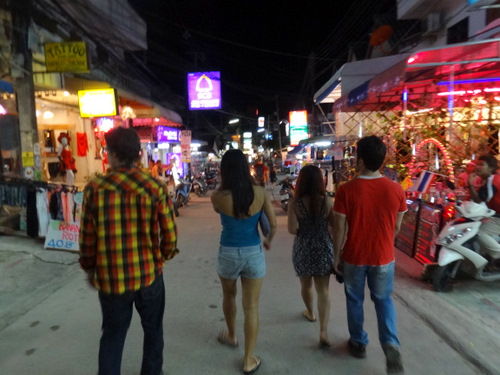
Met up in Koh Phangan with a bunch of friends made through a Couchsurfing meetup.
Here are some rules for making friends safely:
1) Don’t try to break into large groups of men. They’re not that much fun, anyway – they usually want to drink as heavily as possible, talk about sports, and light things on fire.
2) Don’t go chat up that dude in his 50’s who’s sitting all alone at the bar, nursing a double scotch. He will think you’re a prostitute.
Other than that, it’s not so bad. Here are prime targets for friending:
1) Another female traveling alone. This is one of the easiest and most promising friendships to be struck. Try spotting her in a hostel’s common area or chilling at a cafe, reading her Lonely Planet.
2) A mixed gender group.
3) Another male, around your age, traveling alone who seems nice.
4) A couple. Good for a casual chat, but unlikely to become your sightseeing partner.
5) Go to meetups. Major cities all have weekly Couchsurfing events where you can meet locals and travelers.
You’ll find that giant social groups naturally form at hostels, but it’s easy to meet people anywhere. As far as safety, just use your common sense. If a dude seems creepy, he probably is. But don’t let that deter you from all the genuinely friendly, uncreepy folks out there. Not much can happen in a well-lit, public area with other people around.
Please, please read my friend Lena’s fantastic blog entry on rejecting pushy dudes for the socially awkward. I think any girl who’s worried about “offending” a guy will identify with what she says.
Conversation starters:
– “Hey, did you mention you’ve been to ____(Amsterdam, Outer Mongolia, Reykjavik)___? What’s it like? I was thinking about going there next.”
– “Do you know where ___ is?”
– “How long have you been traveling for?”
– “Where have you been so far?”
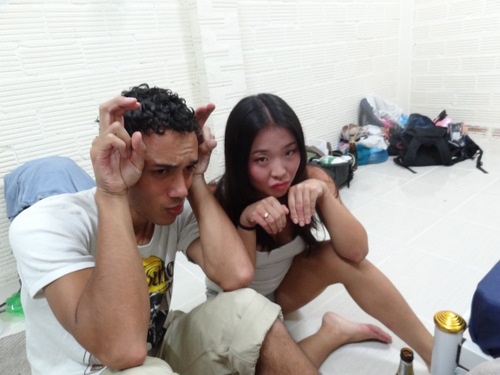
See fake engagement ring on my left hand. Yes, we’re making animal faces. No, I don’t have a better picture of my fake engagement ring.
I bought a fake engagement ring for $3USD in a night market. Not sure how much it has helped. It’s good for quick, easy to rejection at loud parties – just point to your ring finger and shake your head. But I’ve been traveling a lot with people that I’ve met on the road and generally haven’t had any issues.
3. What about meals? I’m sure you’re trying out local cuisine wherever you go. If you want to dine at a relatively upscale place, do you feel comfortable eating alone or do you find someone else? if the latter, how?
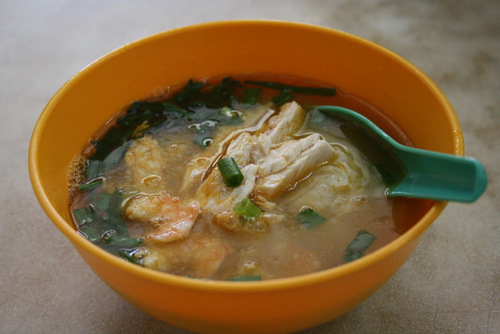
In Southeast Asia, upscale places are usually an expensive disappointment. The best and cheapest food is at street stalls, which are easy to sample by yourself. But I usually eat with someone else anyway. If you meet someone who seems nice earlier in the day, just casually invite them to dinner. They’ll say yes 99.9% of the time. Or maybe you’ll acquire a temporary travel partner. If you meet someone who seems cool and who’s heading in the same direction as you, try planning on catching the next bus together. That way, you’ll save yourself from boredom on long trips and have a new travel buddy in the process.
4. Packing, part 2. You’ve covered a good deal of the packing on the blog already. I had a few questions about packing a camera/laptop/other heavy equipment. There’s obviously a trade off between bringing along a fancy camera to take really nice travel photos and being able to carry all of that and walk for a few hours. What do you do about camera? Do you opt for a compact one? What suggestions would you have for people who want to bring multiple camera bodies/lenses but at the same time still only one backpack, like you suggested on the blog?
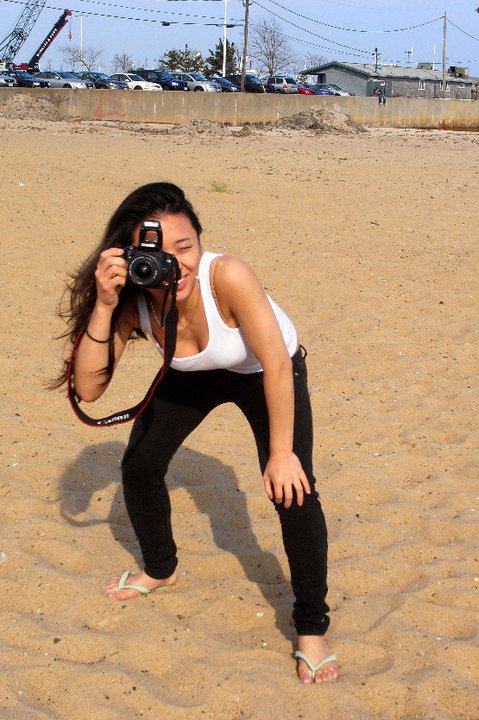
I would err on the side of less equipment, unless photography is a main goal of your trip. I have a DSLR with me and wish I didn’t. It’s fine if you’re taking a shorter trip and not moving around too much, but I’d rather have a high quality compact camera. I usually don’t even carry my camera around because it’s so annoying to have with me.
5. How did you pick your travel locations? Did you plan the whole trip out before you started, or is it more spontaneous? Where have you been?
I’m not entirely typical in that my entire trip has been spontaneous. I ended up in Malaysia and Cambodia by accident. I’d meet someone who mentioned they were crossing the border to X or Y and I’d think, hey, why not? My visa is expiring anyway. You’ll find that there is a well-worn route of bus stops and ferry links – the typical tourist trail, if you will – and that other travelers will be going/coming from the same places. So for overland travel, being totally spontaneous is very much possible. Flights are a little different. Fares vary wildly depending on when you buy them, so better to plan about a month ahead on these to grab the promo fare.
Not planning is fantastic because if you like a place, why not stay longer? Or if you hear about some other cool town, why not go visit? You have to trust that nothing will go too wrong. Because it generally doesn’t. Unless you’re so off-the-beaten-track that finding transportation is an issue. In which case, be a bit more careful.
The most helpful thing is to have a end destination in mind. For me, that’s Shanghai, where my return flight is. So I’ve been meandering across the continent, but I try to keep on a generally northward path. Having a full 4 months means that I never worry about the time.
6. What has your travel experience been like so far? I feel like female travel memoirs like Eat Pray Love or Wanderlust make it all seem so easy, but it’s actually much more difficult in real life (or maybe it’s just me). Have you encountered any difficulties? Memorable experiences?
Travel isn’t hard. Think about it this way: there are millions of other people your age, much stupider than you, who have successfully backpacked across Southeast Asia. In time, you’ll find that the occasional hard bits make for the best stories and memories.
Probably the most annoying thing that’s happened is my skin flaring up like crazy. Nonstop traveling is tough on your body, particularly in an unfamiliar climate, so I’ve been careful to pick rooms with A/C, get enough sleep, and give myself long breaks. The most likely difficulty you’ll encounter is getting ripped off. But I’ve felt myself really grow in this respect – I’ve learned how to bargain without getting offended about being scammed, and sometimes just accept that I’ve been scammed. (It’s just a few bucks. No big deal.)
The most important thing I’ve gained is a sense of humor and patience in dealing with unfamiliar situations. Sometimes a bus will mysteriously break down, or drop you off at some random travel shop for 2 hours while you wait for an unexpected transfer. You just learn to stretch your legs, buy some pineapple, and pet a local kitten. Bring a book to read – there are book swaps at most guesthouses once you’re done with it.
As a side note, you’ll find that frequently touristed places – like any major city or place listed in the Lonely Planet – are really, really easy to navigate. Tons of people speak passable English and signs/menus/schedules will be available in English. It’s also helpful to have a phone to meet up with all your new friends, either with a local SIM card or prepaid phones. I’ve been trying to get by on wifi and Skype, but this is proving to be antisocial and a Really Bad Idea.

As for memorable experiences, there are too many to count. Friendly people, beautiful sunsets, inexplicable scenarios, massive parties, and moments of unexpected awe.
7. Who takes your photos?
I take photos with my camera, but as far as pictures of me, usually a travel partner or staff member.
8. How do you fund your travels?
I happen to freelance as a web designer while I travel, so I can work from the road. However, there are a million other ways to finance your travel that don’t involve having technical skills and a wifi connection. Some people just save up before they leave. (You only need $30-50 a day to travel very comfortably in SE Asia. Less, if you’re willing to forgo some creature comforts.) Many hostels will let you work a few hours a day in return for free room and board. I’ve met people who taught English, played online poker, worked at hotels, or just lived at home and saved up some cash from a secretarial or bartending job before heading out.



